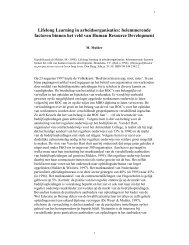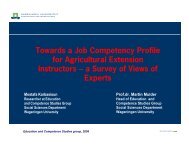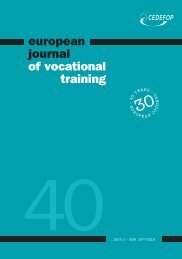The concept of competence: blessing or curse? - Martin Mulder, PhD
The concept of competence: blessing or curse? - Martin Mulder, PhD
The concept of competence: blessing or curse? - Martin Mulder, PhD
- No tags were found...
You also want an ePaper? Increase the reach of your titles
YUMPU automatically turns print PDFs into web optimized ePapers that Google loves.
individual job <strong>competence</strong> pr<strong>of</strong>iles like there are individual job descriptions. But also from a feeling <strong>of</strong>ownership individual <strong>competence</strong> pr<strong>of</strong>iles are imp<strong>or</strong>tant. Bottom-up development and agreement onthe specific <strong>competence</strong> pr<strong>of</strong>iles is raising the feeling <strong>of</strong> ownership <strong>of</strong> the pr<strong>of</strong>ile.Competence centres: <strong>competence</strong> centres are units in <strong>or</strong>ganisations which have a specific field <strong>of</strong>expertise. <strong>The</strong>y can be IT service desks, sales teams, <strong>or</strong> procurement units f<strong>or</strong> instance. Competencecentres may also have an external function and serve as a unit in a value chain <strong>or</strong> as a service <strong>or</strong> eventraining centre. In the latter case <strong>or</strong>ganisations sometimes use the term <strong>competence</strong> centre f<strong>or</strong> theseunits f<strong>or</strong> marketing reasons.Competence assessment in selection process <strong>of</strong> new employees: employee selection has been and stillis an imp<strong>or</strong>tant function <strong>of</strong> human resource management. Costs <strong>of</strong> employee selection is <strong>of</strong>ten high,not only because <strong>of</strong> the selection process itself, but also because <strong>of</strong> the period <strong>of</strong> subsequentemployment and the ultimate productivity <strong>of</strong> the candidate. Assessment <strong>of</strong> <strong>competence</strong> has come inbecause <strong>of</strong> the value added in the selection process. <strong>The</strong> most elab<strong>or</strong>ate f<strong>or</strong>m <strong>of</strong> <strong>competence</strong>assessment is the assessment centre. This is a process which regularly takes a day (<strong>or</strong> two) in which acandidate has to perf<strong>or</strong>m a series <strong>of</strong> simulated tasks which are as much authentic as possible. Incertain cases pr<strong>of</strong>essional act<strong>or</strong>s are involved in actual role plays. Task perf<strong>or</strong>mance is observed andanalysed using specific behaviour dimensions. Feedback rep<strong>or</strong>ts are given to the candidates, who arethe owner <strong>of</strong> the rep<strong>or</strong>ts, but who may want to share the inf<strong>or</strong>mation with their supervis<strong>or</strong>s.Acknowledgement <strong>of</strong> inf<strong>or</strong>mally acquired <strong>competence</strong>: this is also known as the accreditation <strong>of</strong> pri<strong>or</strong>learning. <strong>The</strong> process also comprises <strong>of</strong> an assessment <strong>of</strong> <strong>competence</strong> but f<strong>or</strong> a different reason asthe previous instrument. In this case the result is being used to compose a study program in which theexperience and pri<strong>or</strong> learning is being taken into account to avoid overlap between the expertise <strong>of</strong>the candidate and the content <strong>of</strong> the study programme. Using this instrument results in m<strong>or</strong>eefficient study programs f<strong>or</strong> the participants. <strong>The</strong> final goal <strong>of</strong> the accreditation is that candidatesreceive an <strong>of</strong>ficial qualification <strong>of</strong> a certain education <strong>or</strong> training institute which gives recognition tothe candidate. This is especially rewarding f<strong>or</strong> lower educated employees.Competence assessment f<strong>or</strong> employee evaluation: there are many different kinds <strong>of</strong> employeeevaluations. A very common method is the annual perf<strong>or</strong>mance appraisal. This consists <strong>of</strong> comparinglast year’s perf<strong>or</strong>mance with job descriptions and the attainment <strong>of</strong> results agreements. <strong>The</strong>assessment <strong>of</strong> <strong>competence</strong> can be included in the perf<strong>or</strong>mance appraisal cycle. This is regularly doneby self-assessment <strong>of</strong> <strong>competence</strong>, multi-rater feedback <strong>or</strong> 360-degree feedback.Marketing products/services with <strong>competence</strong> on the label: this is done in advertisements <strong>or</strong> othermarketing expressions. <strong>The</strong>re are countries in which it is not unusual to see l<strong>or</strong>ries withannouncements <strong>of</strong> <strong>competence</strong> fields <strong>of</strong> the products being transp<strong>or</strong>ted. <strong>The</strong> intention <strong>of</strong> marketingproducts and services by using <strong>competence</strong> phrases in texts <strong>or</strong> other media presentations is tosuggest that the producer <strong>of</strong> service deliverer has a high level <strong>of</strong> expertise in the respective field. This<strong>of</strong> course only makes sense if the product <strong>or</strong> service really is <strong>of</strong> high quality.Coaches to employees f<strong>or</strong> <strong>competence</strong> development: <strong>or</strong>ganisations can appoint <strong>or</strong> contract coaches toassist employees to develop certain competencies. A basic level <strong>of</strong> motivation and an open mind todevelopment is required to make coaching effective. Coaches can confront employees with elements<strong>of</strong> their perf<strong>or</strong>mance, behaviour <strong>or</strong> personal beliefs which may not be productive <strong>or</strong> consistent withtheir c<strong>or</strong>e values and aims. Coaches may <strong>or</strong> may not participate in w<strong>or</strong>k processes in which they canobserve the employee.8 | P a g e







